Restore your gut flora naturally with a thermal bath
- Nature Source Chaude
- Published on
- Updated on 27 September 2025
A recent study published in Scientific Reports [1] examined the impact of soaking in Japanese hot springs, known as ‘onsen’, on the gut microbiota of healthy individuals. The results were surprising and unprecedented: it was found that simply immersing oneself in a hot spring significantly improves gut health within just one week. This study will change the way you look at hot springs forever.
Table of Contents
Taking baths – a centuries-old tradition in Japan
Soaking in water is a deeply rooted tradition in Japan. Indeed, it is common in Japanese households to share a bath. This practice is not just about hygiene; it is also a ritual of relaxation that strengthens family ties between generations. This enables all family members to enjoy the many benefits of a hot bath without necessarily being aware of them. Read our article on the subject to find out more.
Japan has one of the world’s highest concentrations of hot springs, with over 27,000 onsen and more than 3,000 onsen establishments. For the Japanese, enjoying the benefits of a hot spring bath at an onsen is a veritable institution, governed by rules of conduct that differ from those practised in the West.
Therefore, Japan has a wide variety of thermal waters that are used for therapeutic or recreational purposes. Each type of water has multiple characteristics and specific features. However, Japanese law classifies them into ten categories, or ‘types of spa’. The list includes:
- Simple water must have a minimum temperature of 25°C and contain insufficient minerals to qualify for any of the other categories. The level of dissolved substances must be less than 1 g/l. In France, waters with a low mineral content are classified into one of the other categories directly;
- bicarbonate water;
- sulfate water;
- Sodium chloride water;
- Sulfur water – these waters can be identified by their distinctive smell of rotten eggs. They must contain at least 2 mg/l of hydrogen sulphide;
- etc.
As we will see in the following study, thermal springs have a very positive effect on intestinal flora. However, these effects vary depending on the nature of the thermal water and therefore the type of spa.
Thermal baths and gut microbiota: an unexpected connection
We now know that the gut microbiota plays a vital role in maintaining human health. This influences various physiological processes, such as digestion, metabolism and immune regulation.
Although stable over time, the gut microbiota can fluctuate due to environmental changes or lifestyle choices. This is particularly the case when we change our diet, for example by eating more fruit and vegetables. According to a study[2], 2% of human gut microbes come from the fruit and vegetables we eat. This highlights the importance of choosing fresh produce grown in high-quality soil rich in microorganisms.
However, the effect of environmental factors, especially bathing in thermal waters, on the digestive tract’s microbial ecosystem remains relatively unexplored.
About the study
The study was conducted in Beppu, a coastal city in eastern Kyushu, Japan. Beppu is home to the largest concentration of hot springs in Japan, with over 2,800.
The research involved 127 participants who had not taken a thermal bath in the previous two weeks and who were free from chronic illnesses.
They were invited to soak in the hot spring of their choice before being divided into four groups based on the chemical typology of the water: simple, chloride, bicarbonate, sulfur or sulfate. Each group soaked in the same pool for at least 20 minutes a day for seven consecutive days. They provided stool samples before and after the experiment to analyse their gut microbiota.
Findings of the study
The results showed that levels of certain microorganisms in intestinal flora increased significantly following thermal bathing, depending on the type of thermal water used.
Before-and-after comparisons were made for 20 types of bacteria across the four groups. Figure 3 below, however, shows only the groups in which the relative abundance of certain bacteria changed significantly. No significant changes were observed before and after bathing in the group using chloride springs.
The results revealed a significant increase in the presence of seven bacteria in the gut microbiota following bathing.
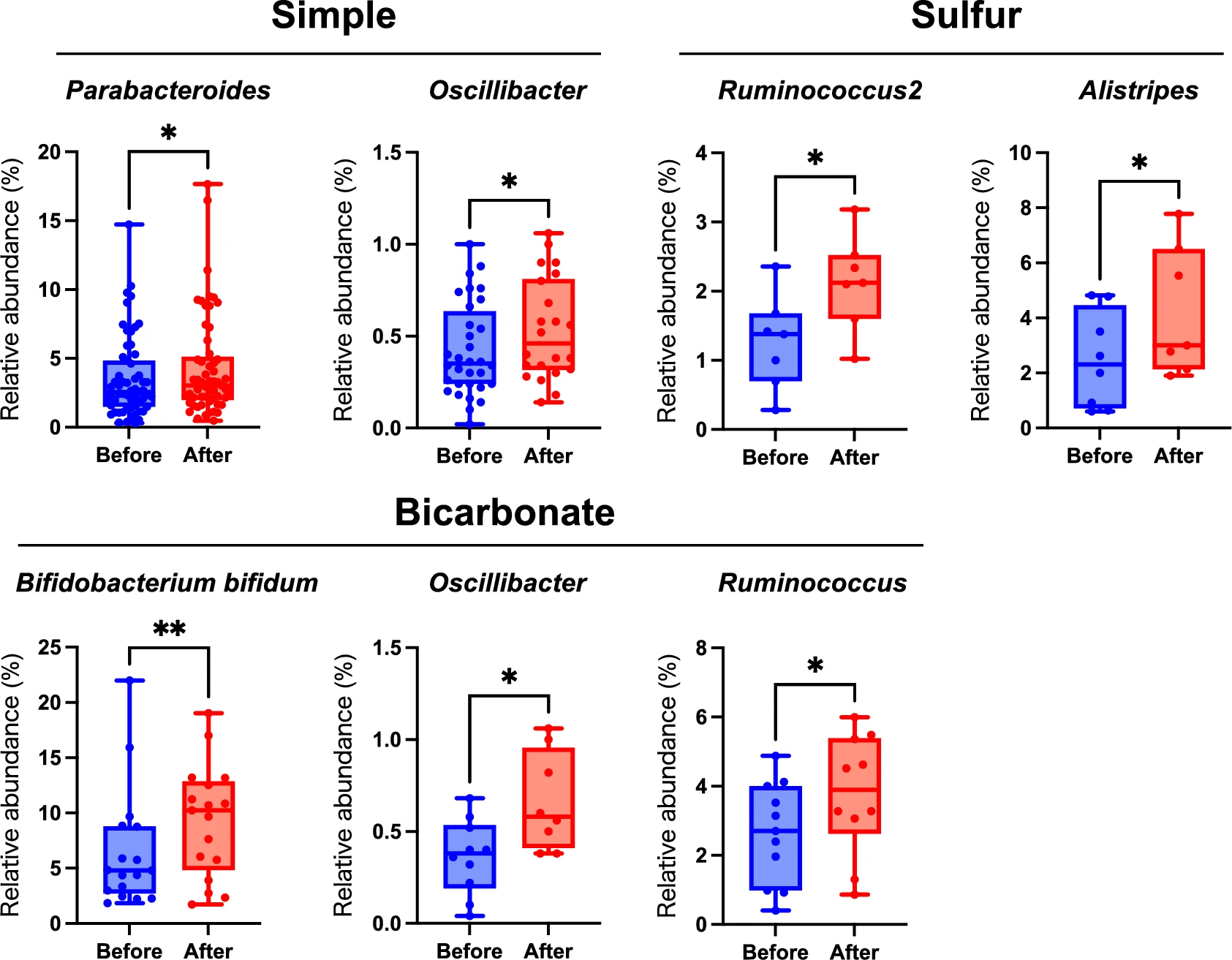
Of these bacteria, Bifidobacterium bifidum showed the greatest variation, increasing by 2.8% among individuals who bathed in bicarbonate-rich springs. This bacterium belongs to the genus Bifidobacterium, which comprises 32 species.
♨️In conclusion:
This is the first study to examine the impact of thermal baths on gut microbiota. The results show that this impact can extend far beyond the usual physiological effects on the skin, bones, or joints. Depending on the type of thermal spring, baths can alter the gut microbiota in distinct ways, increasing the concentration of certain bacteria.
Note that the effect of the bath on the gut microbiota can be increased by prolonging its duration (at least 20 minutes in the study) or by combining different hot sources.
However, as we will see in the next section, the choice of onsen should not be based solely on its chemical composition. The waters’ effects are more dependent on quality than quantity.
The choice of onsen
In Beppu, there are onsen where visitors can soak their feet in thermal water directly from its source. Some of these are even free to use!
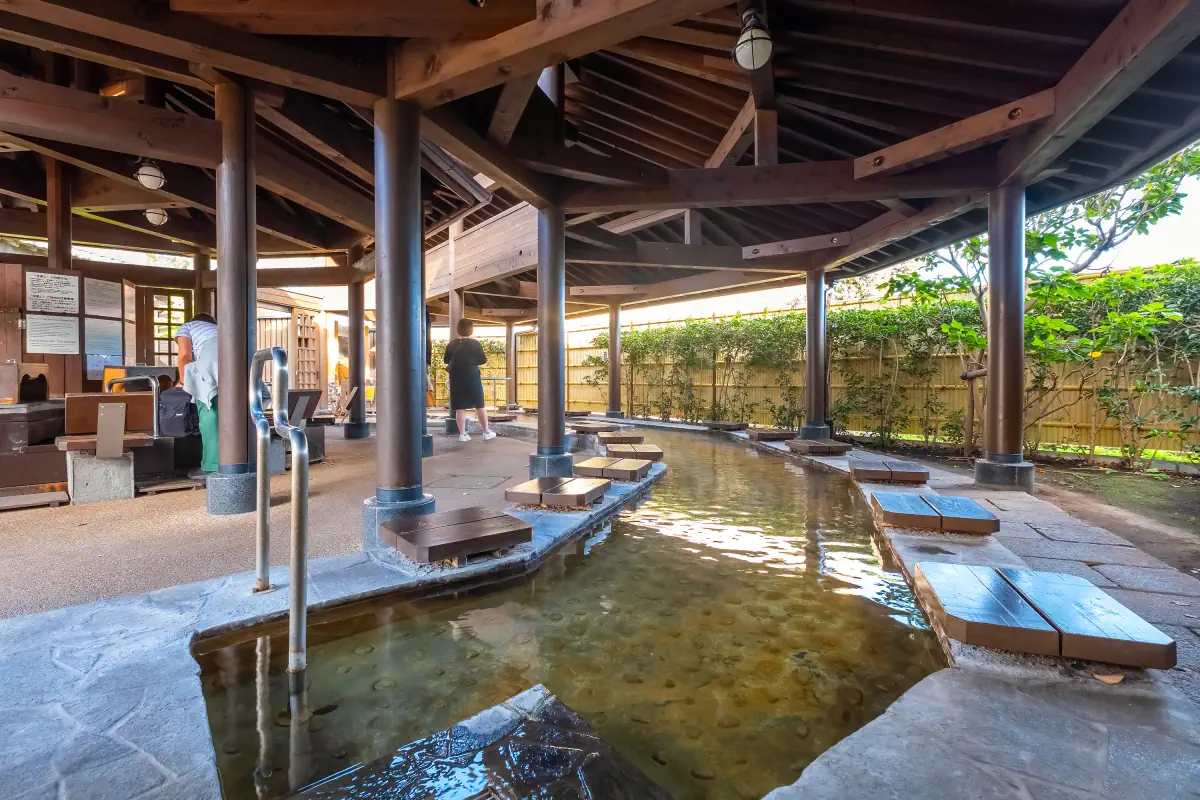
Visitors can also visit the thermal establishments to enjoy a bath in a bathtub or pool.
For an establishment to be well established among onsen enthusiasts, the temperature of the water in the bath or pool must be constant and close to body temperature. This can only be achieved with a plentiful supply of thermal water.
When the flow rate is insufficient to fill a large number of bathtubs, pools become essential for establishments. Indeed, it takes less water to fill a pool that can accommodate 20 people than it does to supply an equivalent number of bathtubs with water at a constant temperature.
In order to maintain a constant temperature, water in a bathtub or pool must flow continuously. This means that bathers are immersed in an environment that is constantly being renewed, with new molecules replacing those that have lost their effectiveness. This effect is more significant when the renewal rate is high. However, achieving this is much more difficult than it seems. This is why establishments use different treatments before the water reaches bathers.
As mentioned in the Japan-Guide article, the best onsens are designated ‘Gensen Kakenagashi’ and do not use any treatment. Water treatments may consist of:
Untreated water (gensen kakenagashi)
‘Gensen Kakenagashi’ literally means ‘natural hot spring water flowing directly from the source and overflowing continuously’. It is characterised by hot spring water flowing directly from the source into the bathtub, with the water overflowing continuously, 24 hours a day, 365 days a year, without any treatment or reuse. This practice is known as ‘bain en eau courante’ (bathing in running water) in France (see our article). This method of bathing requires a large quantity of thermal water, which, at the point of emergence, is not significantly different in temperature to that used for bathing. It is said that fewer than 5% of Japan’s thousands of onsen are 100% authentic Gensen Kakenagashi! These are the premium hot spring resorts. Another point to consider is: is the source natural or drilled? Does it flow naturally or is it pumped?- Cooled water
The water in many hot springs is too hot to bathe in without cooling it down first. Establishments use various methods to cool the water down. Some of these methods are described in an article on the Japan Guide website. - Heated water
There are also many thermal springs whose water is too cold for use in baths and must therefore be heated. While the water may be at an ideal temperature when it emerges from the spring (35°C, for example), it may lose a few degrees by the time it reaches the baths, necessitating heating. - Addition of tap water, reuse of thermal water, chemical treatment of water, etc.
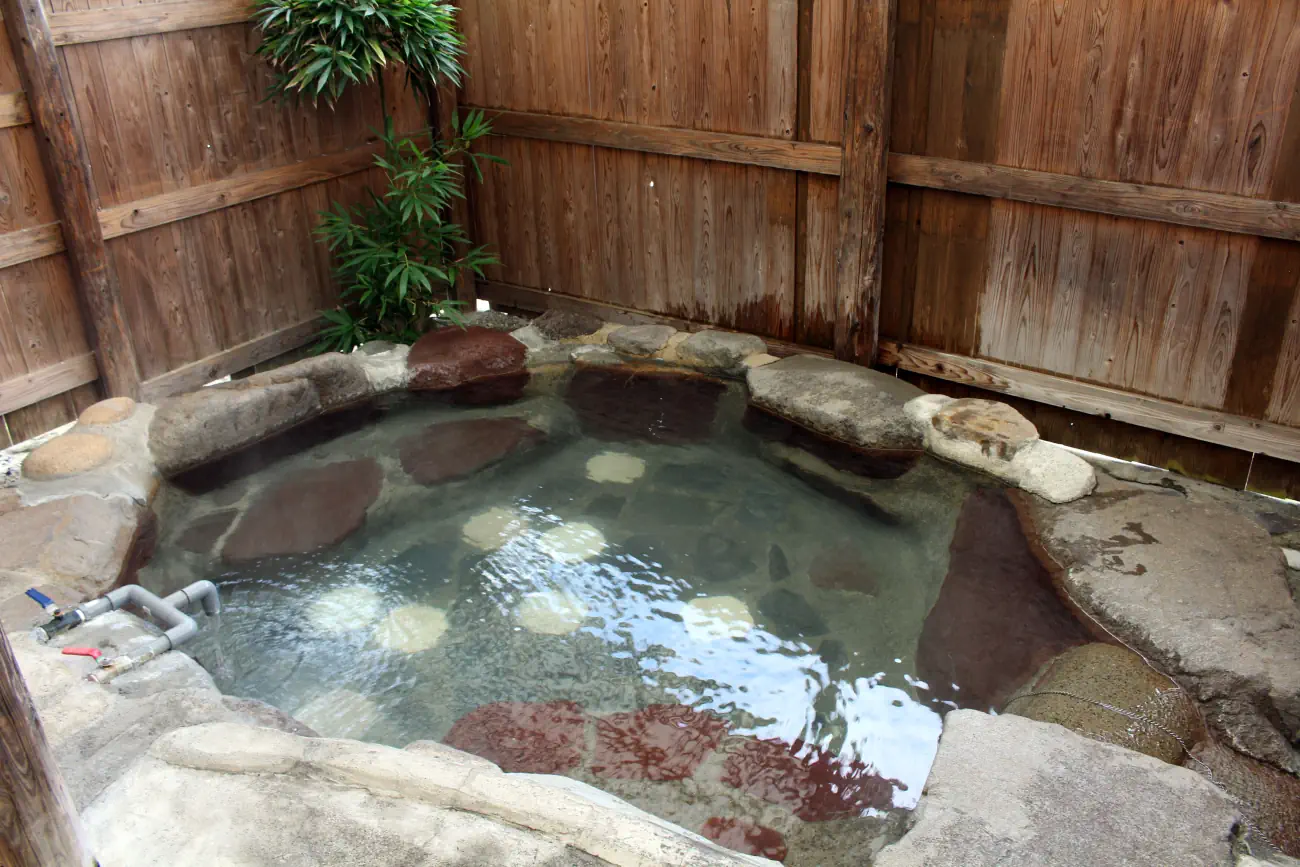
Other hot springs in Beppu are simply geological curiosities. Here and there, the earth smokes, the air shimmers from the heat, and the water bubbles with an otherworldly glow.
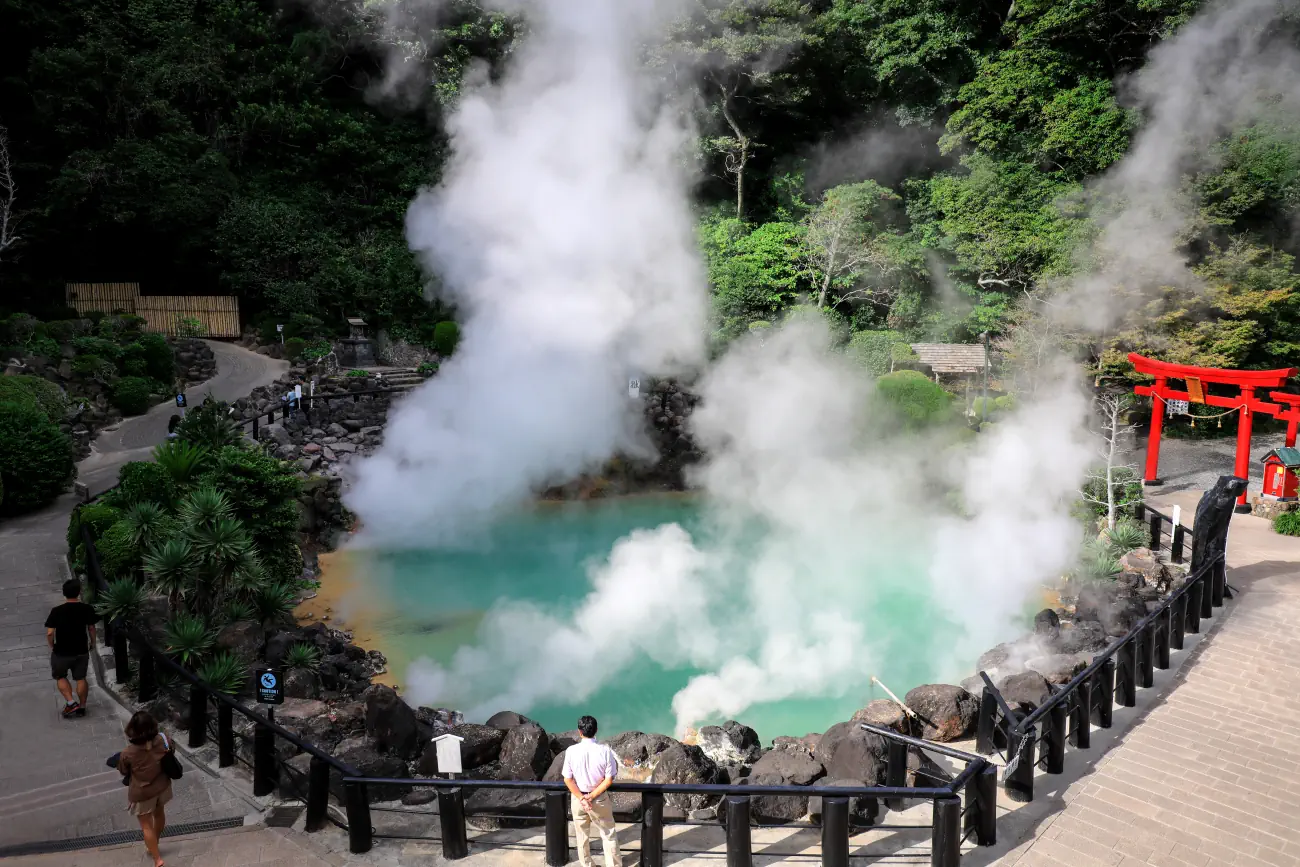
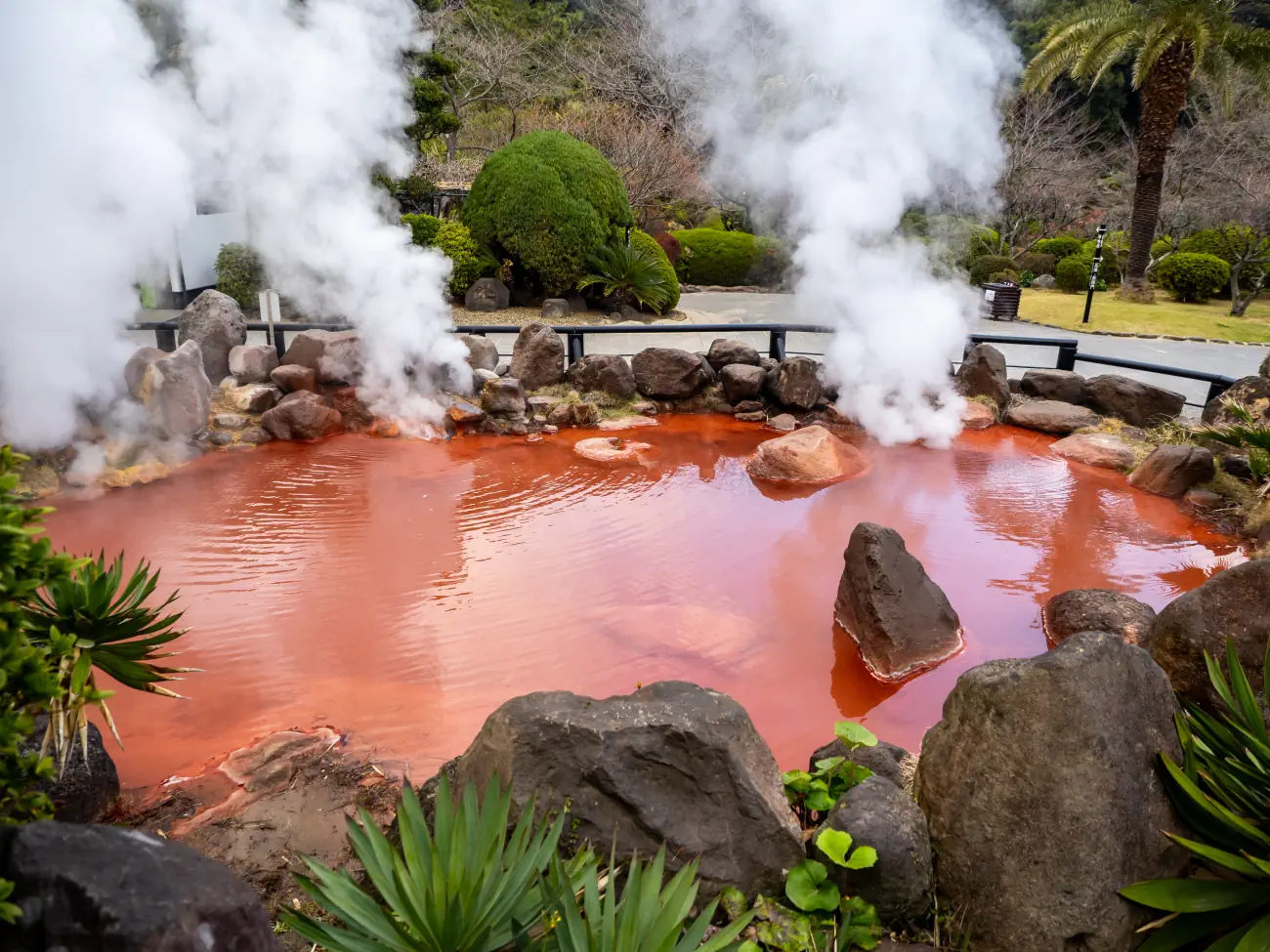
These hot springs are actually home to a whole ecosystem teeming with life, despite water temperatures sometimes reaching 100°C. They are natural laboratories where life has adapted to thrive in these unique conditions.
The organisms living in these springs produce a wide variety of enzymes and molecules that have applications in many different fields, including medicine and industrial processes.
Therefore, hot springs in more natural environments (natural soil, surrounding environment, natural light) tend to have greater microbial diversity in their water and soil. This diverse chemistry can benefit bathers and their intestinal flora. Further information on this subject can be found in the article ‘The soil, base layer and living medium of a hot spring‘.
[1]. Effects of bathing in different hot spring types on Japanese gut microbiota. Takeda, M., Choi, J., Maeda, T., Managi, S. Scientific Reports (2024). DOI: 10.1038/s41598-024-52895-7, https://www.nature.com/articles/s41598-024-52895-7
[2]. Wicaksono WA, Cernava T, Wassermann B, et al. The edible plant microbiome: evidence for the occurrence of fruit and vegetable bacteria in the human gut. Gut Microbes. 2023;15(2):2258565.






